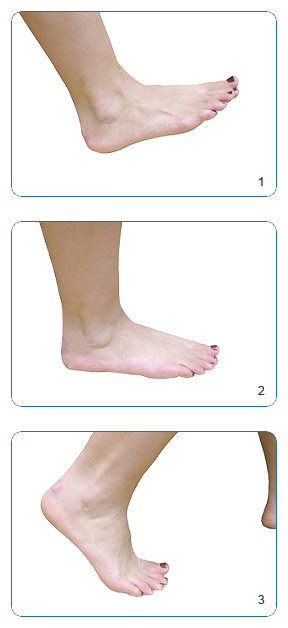Patient Education
-
- Achilles Tendonitis
- Ankle Equinus
- Arthritis of Big Toe joint
- Bunion
- Callus
- Capsulitis
- Flatfoot: Acq'd. PTTD
- Ganglion cysts
- Gouty Arthritis
- Hallux Varus
- Hammertoe deformity
- Ingrown toenails
- Kohler’s Osteochondroses
- Limb Length Inequality
- Metatarsal Arthralgia
- Metatarsal Stress Fracture
- Neuroma - Intermetatarsal
- Pediatric Flat Foot
- Peroneal dislocation
- Peroneal tendon tear
- Plantar Fasciitis
- Plantar Fibroma
- Retrocalcaneal Bursitis
- Sesamoid Fracture
- Shin Splints
- Tarsal Tunnel Syndrome
- Tailor's bunion
- Toenail Fungus
- Warts - Verruca Plantaris
-
- Overview
- Diabetic Shoes
- Shoe Modification
- Accommodative Orthotics
- Ankle Foot Orthosis (AFO) - Overview
- Richie Brace® - AFO
- Dorsiflexory Assist Device (Allard® ToeOFF Brace)
- Gauntlet AFO (Arizona®)
-
- Overview
- Preoperative Care
- Day of Surgery
- Postoperative Care
- Bunionectomy
- Bunionectomy - Post-Op
- Neuroma Surgical Care
- No Barefoot Walking
- Activity Limitations
-
-
-
-
-
Overview
The act of walking and running is essentially a controlled fall. Each foot is coordinated to provide the same functions at almost directly the opposite time from each other. One foot is in the air while one foot is on the ground. This statement holds closer to true in running as compared to walking because the velocity or speed of forward motion is faster. The phase of walking that the foot is in the air is called the “swing phase” of gait while the phase of waling that the foot in on the ground is called the “stance phase” of gait.
The foot while in the air is a coordinated motion using the hip flexors, quadriceps muscles of the upper leg and the front extensor muscle group of the lower leg. This coordinated activity prepares the foot for the “stance phase” of gait. It is during the stance phase of gait that a majority of the important foot biomechanics occur. During the stance phase of gait there are three distinct phases of foot contact. Heel strike occurs at the time the heel contacts the ground, midstance occurs when the foot is fully contacting the ground from heel to toe and propulsion occurs as the foot prepares to lift the heel off of the ground initiating the next swing phase cycle.
Pronation and Supination
During the stance phase of gait there is a coordinated foot motion called pronation and supination. Pronation and supination are somewhat difficult to explain due to their complexity but it is important to remember that the foot during walking needs to be flexible enough to walk on irregular surfaces and it needs to be rigid enough to provide the support that is required as the heel lifts off of the ground. Pronation of the foot allows the foot to be flexible and supination of the foot allows the foot to be rigid.
During the gait cycle, the foot is able to alternate between rigidity and flexibility because of the construct of the arch. As a simple rule, when the arch is high, the foot acts as a rigid lever, providing a stable platform for support and pushing off or propulsion. When the arch is low or in a pronated position, the foot is flexible for conforming. Any abnormality in the positioning of the foot during the gait cycle can lead to improper foot function.
Pronation is complex motion of the foot that occurs in three body planes simultaneously during walking. Pronation describes the motion and position of the foot when it flexes upward (dorsiflexion), turns away form the body (abduction), and the heel rolls outward (everted), all occurring simultaneously. Pronation is considered normal because it is required for normal walking and running.
Pronation and supination of the foot during the stance phase portion of the gait cycle occurs at predictable times. If the foot pronates excessively during the late portion of the midstance portion of the stance phase the foot structure will be unstable as the heel lifts off of the ground during propulsion. An unstable foot leading into propulsion increase the risk for the development of foot pain and injury.
Pronation-based Injuries
Excessive pronation has been an associated contributor to many adult foot and ankle pathologies including the development of heel pain, bunions, hammertoes, shin splints, stress fractures, and many other chronic overuse injuries. Many patients may not have a specific area of pain that they can localize but experience “generalized foot pain”. Foot pain like this is often times noted to be worse with initial weight bearing activity and then improves after a short period of walking.
Treatment for pain and foot problems associated with abnormal foot pronation includes the selective use of a supportive shoes and orthotics. The excessively pronated unstable foot can become painful related to increased stresses to the soft tissues including muscles, ligaments and tendons. The shoe and the orthotic work together to decrease abnormal foot pronation during midstance by placing the foot in a more rigid position during propulsion or heel lift. It is during the midstance phase of the gait cycle as it leads to propulsion that appears to play a significant influence in the development of many foot pathologies. The shoe and the orthotic place the foot in a more stable construct which transfers loading stresses away from the soft tissues and onto the bony skeleton.
Schedule an Appointment

Please call 805.543.7788 for San Luis Obispo, 805.434.2009 for Templeton, or email us to request an appointment.

